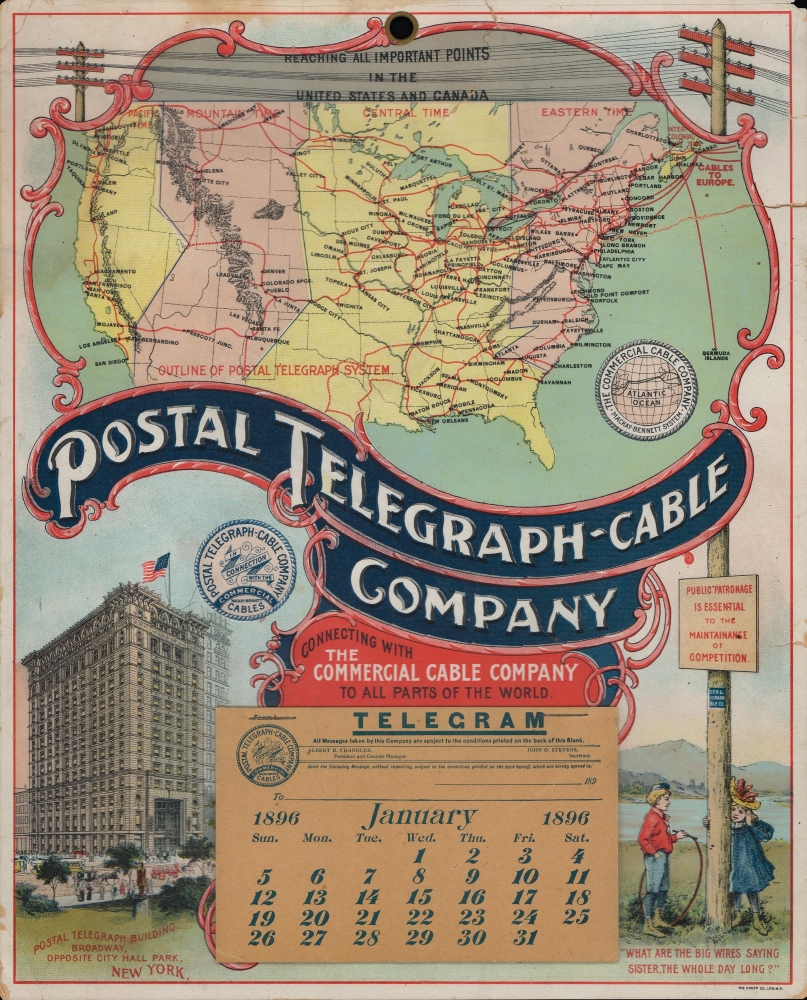1896 Knapp / Postal Telegraph-Cable Co. Calendar Map of the United States
TelegraphCalendar-knapp-1896
Title
1896 (dated) 11.75 x 9 in (29.845 x 22.86 cm) 1 : 25535000
Description
A Closer Look
This sheet includes a map of the United States and parts of Canada, with the company's network denoted in red, and proposed lines or lines under construction appearing as dashed lines.At bottom-left, an illustration of the company's grandiose headquarters near Manhattan's City Hall Park. The building still stands (at 253 Broadway), more or less as depicted here, but has since been merged with neighboring structures, now known collectively as the Home Life Building.
Public Patronage
A vignette of children scrutinizing telegraph poles and wires appears at bottom-right. A signpost states that 'Public patronage is essential to the maintenance of competition.' This sentiment might seem incongruous to a modern reader, but reflects the role that the federal and state governments played in establishing railway, telegraph, and other communications networks in the 19th century. It also obliquely references the company's rivalry with Western Union, a microcosm of broader concerns about monopolies.Chromolithography
Chromolithography, sometimes called oleography, is a color lithographic technique developed in the mid-19th century. The process involved using multiple lithographic stones, one for each color, to yield a rich composite effect. Oftentimes, the process would start with a black basecoat upon which subsequent colors were layered. Some chromolithographs used 30 or more separate lithographic stones to achieve the desired product. Chromolithograph color could also be effectively blended for even more dramatic results. The process became extremely popular in the late 19th and early 20th centuries when it emerged as the dominant method of color printing. The vivid color chromolithography produced made it exceptionally effective for advertising and propaganda imagery.Publication History and Census
This print was produced by the Knapp Company for the Postal Telegraph-Cable Company in late 1895. This is the only known surviving example.CartographerS
Joseph Fairchild Knapp (July 1, 1832 - September 14, 1891) was an American printer and publisher active in the second half of the 19th century. From the age of 16, Knapp apprenticed as a lithographer under Napoleon Sarony (1821 - 1896) and Henry B. Major (18?? - 18??), at the firm of 'Sarony and Major.' Henry Major either died or left the firm around 1853, with, possibly, his shares being held in reserve for his son, who was then still an apprentice, Richard C. Major. In 1857, Sarony left the firm to travel and study in Europe, Knapp and Richard Major took over the firm, becoming partners, renaming the business 'Sarony, Major and Knapp' (1857 - 1863). It is unclear why Sarony's name was maintained, possibly to capitalize on his fame, as a honorific, or possibly because he owned a major stake. Nonetheless, in 1863, Sarony, who had been absent for 7 years, was pushed out of the company which was was renamed 'Major and Knapp.' They published under this imprint from various locations over the years: 449 Broadway (1864 - 1866), 71 Broadway (1867 - 1872), and 56 Park Place (1889 - 1892). Richard Major retired in 1888, and the firm was renamed Knapp and Company. The firm grew to become one of the largest lithographic presses in the United States and a major force in American printing. Knapp invested some of his considerable wealth into insurance concerns. In 1868, he was the largest shareholder and director, and chairman of the Metropolitan Insurance Company. He became president of the Metropolitan Insurance Company in 1871, pioneering the idea of the low-cost life insurance policy, propelling MIC to become one of the largest insurers in the United States. All the time, he also continued to operate and manage his printing business, which he passed on to this son Joseph Palmer Knapp (1864 - 1951). Palmer Knapp closed 'Knapp and Company' in 1982, a year after his father's death, to establish the American Lithographic Company, which consolidated various smaller printers under a new imprint. Knapp constructed a large and elegant mansion in Brooklyn, which stood at 554 Bedford Avenue. More by this mapmaker...
Postal Telegraph-Cable Company (1886 - 1943), or more simply the Postal Telegraph Company, was founded by Irish-American industrialist John William Mackay. After striking it rich as one of the 'Bonanza kings' of the Comstock Lode in Nevada, Mackay launched a series of business ventures, including the Commercial Telegraph Company in 1884, designed to challenge the near-total monopoly of Jay Gould's Western Union Telegraph Company. In 1886, he founded the Postal Telegraph Company and laid two transatlantic cables, significantly reducing the costs of transatlantic telegraphy. He continued to expand his network, founding the Commercial Pacific Cable Company and other companies before his death in 1902, whereupon his son Clarence took over management of his companies. At its height, the Mackay network reached from Manila and Shanghai to Europe, forming the only real alternative to Western Union in the late 19th and early 20th centuries. The companies ran into financial difficulties and were acquired in toto by International Telephone and Telegraph (I.T.T.), but continued to function until the Communications Act of 1934 forced it to merge with Western Union. Learn More...

